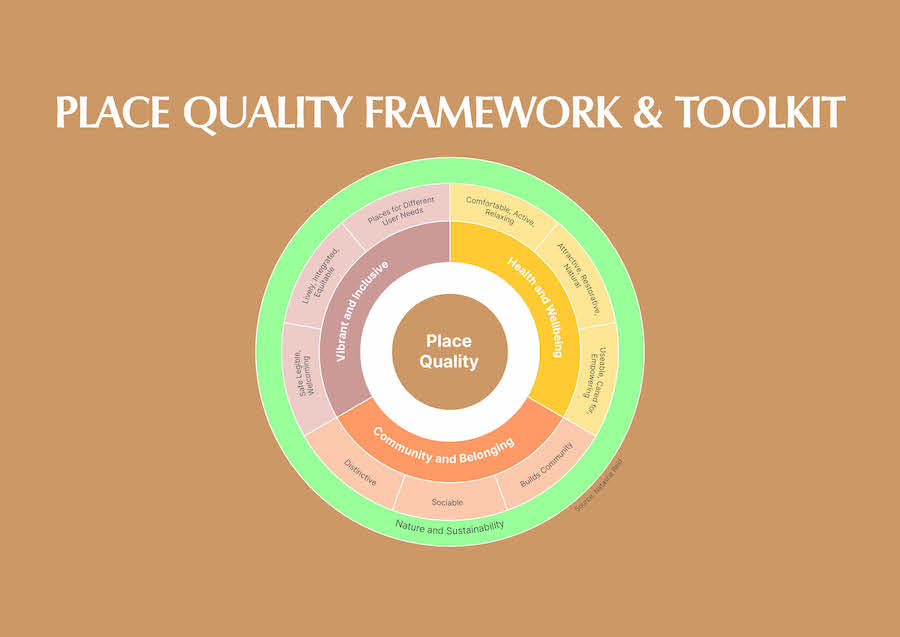Science & research / Placemaking and public realm
London council introduces framework to help set “place quality” benchmark
By Andrew Sansom | 09 Mar 2023 | 0
A London borough council is looking to implement a new planning quality framework to embed considerations of health, social impact, inclusivity and equity into the design and assessment of new development in the area.
Developed by Natasha Reid, founder of urban design practice and wellbeing consultancy Matter Space Soul, the new ‘Place Quality Framework and Toolkit’ is based on her long-term cross-disciplinary research and evidence-based approaches in developing a ‘Human Performance’ framework. Her approach is based on the aspiration to make healthy, happy, liveable, vibrant and inclusive places an everyday reality, accessible to the many, not the few.
Brent Council has introduced the new guidance into its new draft Residential Amenity and Place Quality Supplementary Planning Document (SPD), which is out for public consultation until 30 March. The draft SPD clarifies the borough’s expectations for well-designed places and supports the objectives in the Council’s Local Plan to ensure that new homes and neighbourhoods are designed to provide a high quality of life.
“With the growing evidence and awareness of the significant effects of the built environment on people’s lives, this guidance will contribute to making Brent a healthy, happy, liveable, vibrant and inclusive place,” the Council says of the new framework.
“It helps us set a new benchmark for ‘place quality’, which can guide and shape future development in Brent, ensuring we’re maximising opportunities for our residents through sustainable growth that is focused on what matters to people and communities.”
The framework and method reshape expectations for how developments are designed and assessed in order to gain planning permission. Described as a new values-based approach, tool and system, it is said to prioritise “people-focused, socially conscious outcomes and the human experience of places”. Crucially, by stipulating that the benefits for people are defined and demonstrated through design, as part of the planning process, it’s said to create new benchmarks for success.

This involves a shift from quantitative factors – such has metrics of size and numbers – to instead focus on qualitative factors and the outcomes that enrich quality of life. Qualitative objectives include supporting people’s physical and mental wellbeing; enabling social connection; building strong and integrated communities; encouraging vibrancy and intergenerational mixing; nurturing a sense of place and belonging; and fostering a sense of ownership. And by focusing on equity, the framework elevates the importance of considering the impact of development on health disparities.
Implementation and benefits
Bringing joined-up, evidence-based design considerations to the fore, in relation to the human experience of the built and natural environment, the tool is said to provide designers, planners, developers and decision-makers with the clarity they need to identify the strengths and shortfalls of development proposals, and how equitable growth would be achieved.
The framework considers three dimensions of impact: health and wellbeing; community and belonging; and vibrant and inclusive places. Each of these includes three criteria that act as “building blocks” for people-focused place:
- health and wellbeing – comfortable, active, and relaxing places; attractive, restorative, and natural places; usable, cared for, and empowering places.
- community and belonging – distinctive places; sociable places; places that build community; and
- vibrant and inclusive places – safe, legible, and welcoming places; lively, integrated, and equitable places; places for different user needs.
These are all underpinned by an emphasis on the co-benefits of green infrastructure and sustainability.
The associated outcome-focused toolkit helps bridge the gap between identifying the evidence of what needs to be done, and the practical ‘how’ of implementation. In doing so, it raises awareness of the importance of the built environment in improving health, addressing loneliness and isolation, fostering social cohesion and community participation, and promoting inclusivity and equity.
Natasha Reid worked in collaboration with teams at Brent Council to deliver the draft ‘Residential Amenity and Place Quality SPD’ and adapt the Place Quality approach and method to the needs of the public sector and its local context. The draft document and details on its consultation can be found at https://haveyoursay.brent.gov.uk/en-GB/projects/draft-amenity-space-supplementary-planning-document
Organisations involved

